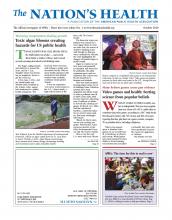Creating environments that support breastfeeding women could save hundreds of thousands of lives and billions of dollars every year, according to a new global health tool.
“We’re fortunate to live in a time when there’s so much evidence on the benefits of breastfeeding,” said Dylan Walters, PhD, who developed the new Cost of Not Breastfeeding tool and serves as a project director at Nutrition International. “Economic evidence can be really powerful for different audiences, especially policymakers and private-sector investors.”
Released this summer, the online tool is designed to help advocates and decisionmakers generate data on the health and economic costs of not breastfeeding at the country, regional and global levels.
The tool, a project of the global nutrition initiative Alive & Thrive, is based on a number of open-access data sources and incorporates three categories of indicators for human and economic costs related to breastfeeding: women’s and children’s morbidity and mortality, health system and household formula costs, and future economic costs linked to breastfeeding-related mortality and cognitive losses.
In a study testing the tool that was published in June in Healthy Policy and Planning, Walters and fellow researchers found that each year around the world, not breastfeeding costs almost 700,000 lives and $341 billion.
“The data are sending us a compelling message: We must do more to support breastfeeding,” said Roger Mathisen, MSc, a study co-author and program director of Alive & Thrive’s Southeast Asia office, in a news release. “With this tool, we hope advocates around the world will be emboldened further in their efforts to obtain greater support from governments.”
Years of previous research shows breastfeeding has a number of health benefits, including reducing the risk of childhood illnesses and premature deaths, minimizing the risk of harm to a child’s cognitive development, and reducing the risk of post-partum hemorrhage and depression for new mothers. Among the annual deaths among children attributed to not breastfeeding, the study found that more than 595,000 of them were due to diarrhea and pneumonia. The tool estimated that breastfeeding has the potential to prevent another 98,000 deaths among women each year from breast and cervical cancers and Type 2 diabetes.
On the economic side of not breastfeeding, global health system costs related to avoidable morbidity and mortality was $1.1 billion each year, while loss of future earnings totaled more than $53 billion. The biggest economic cost, according to the study, was related to cognitive losses, equaling more than $285 billion annually. Study authors described the cost estimates as “conservative.”
“There’s so many benefits to breastfeeding in terms of health, nutrition, bonding, disease risk,” Walters told The Nation’s Health. “But the single most important driver is breastfeeding properties that improve cognition and intelligence.”
The idea for the tool began several years ago with a 2016 study that Walters co-authored on the costs of not breastfeeding in seven countries in Southeast Asia. The following year, government officials in Indonesia cited the study as justification for investing billions into nutrition interventions. As a result of the policy win, Walters said he and colleagues began receiving requests from other governments for breastfeeding cost analyses in their respective countries.
“It occurred to me that if we could tap into enough open-access data, there had to be a way of generating results using data that didn’t require extensive field research,” Walters said.
The resulting Cost of Not Breastfeeding tool includes background on the costs for 34 countries and cost data for more than 100 countries. Walters said many women lack access to the kinds of policy supports and resources that allow for exclusive breastfeeding in the first six months of an infant’s life. He said the tool’s purpose is to help policymakers understand the cost of prevention versus the cost of doing nothing.
“Our tool is designed to show that a policy like maternity leave may not be too expensive — it may actually be low cost when compared to the consequences of not breastfeeding and malnutrition,” he said. “Our goal is to educate on the cost of keeping breastfeeding barriers in place.”
For information or to use the new tool, visit www.aliveandthrive.org/cost-of-not-breastfeeding.
- Copyright The Nation’s Health, American Public Health Association









